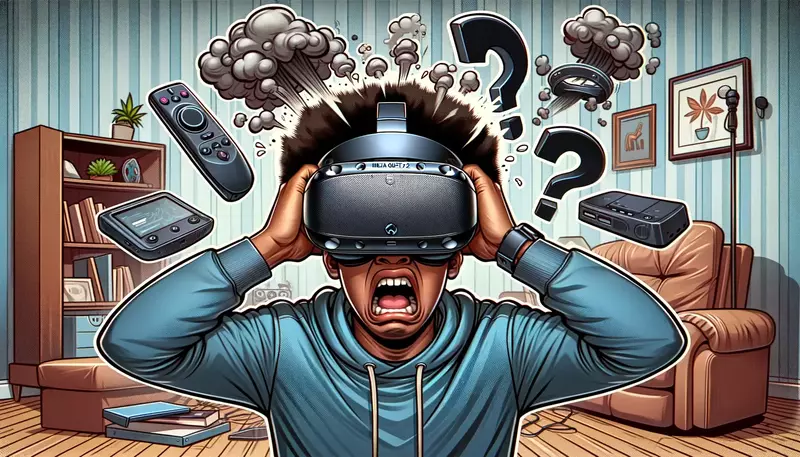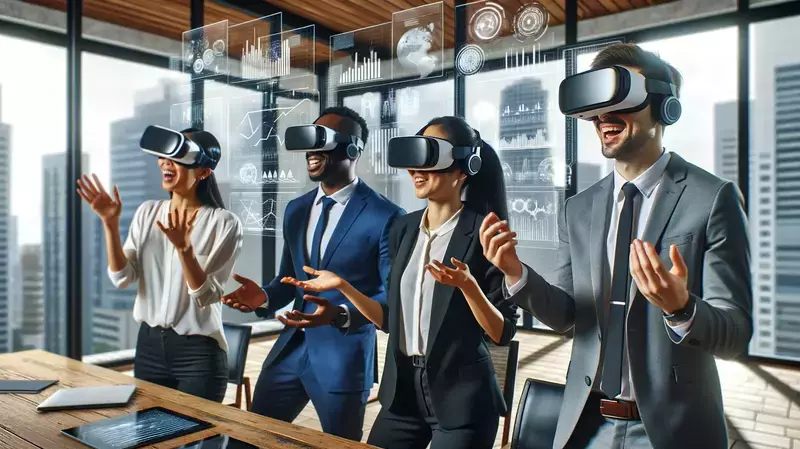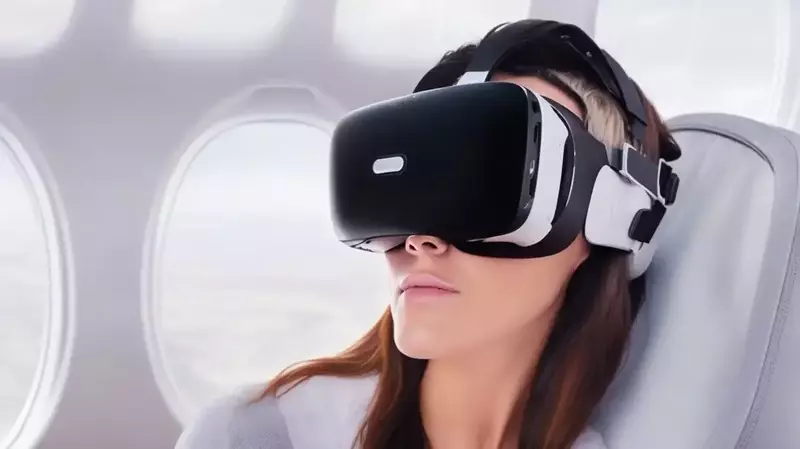This site contains affiliate links to products, and we may receive a commission for purchases made through these links.
Interest in the potential of virtual reality to shape architecture’s future has piqued among experts and aficionados alike. As virtual reality technology continues to advance, it offers architects an array of innovative tools that can revolutionize the way they approach design and communication.
In this blog post, we will delve into the numerous benefits that VR brings to the architecture industry, from enhanced spatial awareness to immersive presentations.

Exploring the Benefits of VR in Architecture
Virtual reality (VR) is changing the game for architects, offering a range of benefits that transform how they design and visualize their projects. Let’s dive into some key advantages of incorporating VR into architectural practices.
Immersive Visualization
VR provides immersive visualizations for both clients and designers. By donning a VR headset, users can experience 3D renderings as if they were in the space itself, enabling them to grasp spatial relationships and make judicious decisions about materials, hues, and other design details.
Streamlined Design Process
Using VR in the design process allows architects to iterate faster on their ideas by making real-time changes directly within the 3D environment. This saves time and reduces costs associated with creating multiple physical models or renderings throughout various stages of development.
Enhanced Collaboration Opportunities
Collaboration between team members, clients, and stakeholders becomes much easier when everyone can virtually walk through a project together – regardless of geographical location – thanks to VR technology.
This enables clearer communication regarding desired outcomes while reducing potential misunderstandings during crucial decision-making phases.
Detailed Analysis & Real-Time Feedback
- Sunlight Studies: With VR tools, architects can conduct accurate sunlight studies, allowing them to optimize natural light within their designs and make necessary adjustments. source
- Acoustic Analysis: VR technology enables designers to simulate the acoustics of a space, helping them identify potential issues and improve overall sound quality in their projects. source
- User Experience Testing: By placing users directly into virtual environments, architects can gather real-time feedback on design elements such as layout, circulation paths, and accessibility features. This helps ensure that the final product meets user needs while minimizing costly revisions later on. source
Incorporating virtual reality into architectural practices provides numerous benefits that lead to more efficient design processes and improved project outcomes.
From immersive visualization capabilities to enhanced collaboration opportunities among team members – VR is truly changing the future of architecture for the better.
Key Takeaway:
Virtual reality (VR) is revolutionizing the architecture industry by providing immersive visualizations for clients and designers, streamlining the design process, enhancing collaboration opportunities, and allowing detailed analysis with real-time feedback. With VR tools, architects can conduct accurate sunlight studies, simulate acoustics of a space and gather user experience testing to ensure that final products meet user needs while minimizing costly revisions later on. Incorporating virtual reality into architectural practices provides numerous benefits that lead to more efficient design processes and improved project outcomes.
How Companies are Implementing VR in Architecture
Virtual reality (VR) technology is changing the game for architecture companies. They are now using it to improve their design processes and workflows. Here are some of the ways they are doing it:
Immersive Design Reviews
VR allows architects to conduct immersive design reviews with clients or team members before construction even begins. This provides a clearer understanding of spatial relationships and scale, leading to real-time feedback and adjustments that can save time and money during the project’s development. [source]
Enhanced Collaboration Between Teams
By utilizing shared virtual environments, architects can work together on projects without being physically present in the same space. This reduces travel costs and increases efficiency overall.
Virtual Reality as a Marketing Tool
Many companies are using VR as an innovative marketing tool for showcasing completed projects or upcoming developments to potential clients or investors. For example, Matterport’s 3D scanning technology creates interactive walkthroughs that allow users to explore properties from anywhere around the world.
This offers a unique way for firms to stand out among competitors. [source]
Integrating VR with BIM (Building Information Modeling)
By combining VR technology and BIM, architects can gain a more comprehensive view of their designs, thus enabling them to make better-informed decisions throughout the project lifecycle.
By integrating these two tools, professionals can more easily visualize design changes within the context of existing building data – leading to better-informed decisions throughout the project lifecycle.
Companies like IrisVR are already developing software specifically designed for this purpose. [source]
Demonstrations at Trade Shows & Events:
- Vividly: A startup called Vividly provides architects with a platform to turn their 3D models into immersive VR experiences, which can be showcased at trade shows or events as an engaging way of presenting projects.
- Architectural Visualization Studios: Many architectural visualization studios now offer VR services, creating virtual walkthroughs and fly-through animations that bring designs to life for clients in ways traditional renderings cannot.
As technology progresses, we can anticipate further fascinating advances in this area.
Key Takeaway:
Architecture companies are utilizing virtual reality (VR) technology to improve their design processes and workflows. VR allows for immersive design reviews, enhanced collaboration between teams, innovative marketing tools, integrating with BIM, and demonstrations at trade shows and events. As technology continues to evolve in this space, we can expect even more exciting developments moving forward.
The Pros and Cons of Using VR for Architecture
As with any technology, there are advantages and disadvantages to incorporating virtual reality into the architectural design process. Exploring the advantages and disadvantages of utilizing VR in architecture is worthwhile.
Pros:
- Better Visualization: VR provides a more immersive experience than traditional methods, allowing clients and architects to better understand how a space will look and feel before construction begins. This leads to better decision-making throughout the design process. ArchDaily discusses how this improved visualization can lead to better decision-making throughout the design process.
- Innovative Design Tools: VR offers architects new tools that can help them create more innovative designs by allowing them to interact with their projects in real-time. For example, software like IrisVR enables designers to walk through their models while making adjustments on-the-fly – something not possible with traditional CAD programs.
- Increased Collaboration Opportunities: With remote work becoming increasingly common, VR provides an opportunity for teams located around the world to collaborate effectively on architectural projects without needing physical proximity. Platforms such as TheConstruct allow multiple users from different locations access shared project files simultaneously.
Cons:
- Cost: Implementing and maintaining VR technology can be expensive, with high-quality VR headsets and powerful computers needed to run them smoothly. Additionally, there may be ongoing costs for software subscriptions or updates.
- Learning Curve: VR is still a relatively new technology, which means that many architects may not have experience working with it. This could lead to a steep learning curve when trying to incorporate VR into their design process – potentially slowing down project timelines initially until they become more comfortable with these tools.
- Limited Adoption: While VR has made significant strides in recent years, not all clients or stakeholders will have access (or interest) in utilizing this technology during the design process. As such, architects must continue using traditional methods alongside VR presentations to ensure everyone involved can fully understand and engage with their designs.
In summary, virtual reality offers exciting opportunities for architectural professionals but also comes with its own set of challenges. By considering the potential benefits and drawbacks of virtual reality, architects can make informed decisions as to whether or not it is suitable for their designs.
Key Takeaway:
Virtual reality (VR) offers architects better visualization, innovative design tools and increased collaboration opportunities. However, implementing and maintaining VR technology can be expensive with a steep learning curve for those unfamiliar with it; while not all clients or stakeholders may have access to the technology during the design process.
What Does Using VR for Architecture Look Like?
Virtual reality (VR) is revolutionizing the way architects design and present their projects.
By creating 3D models and importing them into VR software, architects can navigate through virtual environments and collaborate with team members and clients in real-time.
Here’s a breakdown of the process:
Creating 3D Models
The first step is creating a detailed 3D model of the building or space being designed using software like SketchUp, Revit, or Rhino.
Importing Models into VR Software
Next, the 3D model is imported into VR-compatible software like Enscape, IrisVR Prospect, or Unity, which simulates real-world conditions.
Navigating the Virtual Environment
Architects can then navigate through the virtual environment using a headset like Oculus Rift or HTC Vive, examining every aspect of their project from different angles and perspectives.
Collaborating in Real-Time
VR also allows for real-time collaboration with team members and clients, regardless of their location, through multi-user platforms.
Presenting Designs to Clients
Clients can be immersed in a simulated version of the space they will inhabit once completed, enabling them to gain an enhanced comprehension of its visual and tactile qualities.
Overall, VR is transforming the architecture industry by providing a more immersive and interactive experience for architects and clients alike. It’s no wonder why it’s becoming increasingly popular.
“Architects are revolutionizing their designs with #VirtualReality. Creating 3D models, navigating virtual environments & collaborating in real-time. Learn more about how VR is changing the future of architecture: [insert link] #innovation #architecture”Click to Tweet
The Future of Virtual Reality in Architecture
The future of virtual reality (VR) in architecture is full of possibilities, with new tools and increased collaboration opportunities on the horizon.
As VR technology continues to advance, architects will be able to create more immersive experiences for clients and colleagues alike.
New Tools for Designing Spaces
As VR becomes more sophisticated, we can expect a wider range of architectural design tools that leverage its capabilities. For example, some apps may allow architects to manipulate 3D models within a virtual environment using hand gestures or voice commands.
This would enable them to make adjustments quickly and easily without switching between different software programs.
Better Collaboration Opportunities
Virtual reality has the potential to transform how architects collaborate with one another as well as with their clients.
By allowing multiple users from different locations to interact within the same virtual space simultaneously, it will become easier than ever before for teams working remotely or across time zones.
- Distributed Teams: Architects located around the world can work together seamlessly by meeting up virtually instead of traveling long distances for meetings or presentations.
- Clients: Clients who can’t visit an architect’s office due to distance or other constraints can still participate actively in project discussions through VR environments where they can see designs come alive right before their eyes.
- Sustainability: Reducing travel requirements not only saves time but also contributes positively towards environmental sustainability efforts by cutting down on carbon emissions associated with transportation.
Innovative Construction Techniques
Virtual reality can also play a role in the actual construction process by helping architects and builders visualize complex structures more easily. This could result in the emergence of fresh construction methods that are able to reduce costs, time and resources.
For example, VR-assisted prefabrication allows for components of a building to be assembled off-site before being transported to the final location for installation.
Educational Opportunities
The use of VR in architecture extends beyond professional practice; it has great potential as an educational tool as well. Students studying architecture can benefit from immersive experiences that help them understand spatial relationships and design principles more effectively than traditional methods such as drawings or physical models alone.
In summary, virtual reality is poised to have a significant impact on the future of architecture through new tools, enhanced collaboration opportunities, innovative construction techniques, and educational applications. As technology continues to evolve rapidly over time so too will its influence on this fascinating field.
Key Takeaway:
Virtual reality (VR) is transforming the architecture industry with new tools, better collaboration opportunities, and innovative construction techniques. Architects can manipulate 3D models within a virtual environment using hand gestures or voice commands while clients can participate actively in project discussions through VR environments.
FAQs in Relation to How Vr is Changing the Future of Architecture
How Virtual Reality is Revolutionizing Architecture
Virtual Reality: The Future of Architecture
Virtual Reality: Transforming Industries
The Increasing Significance of Virtual Reality in Architecture
!! For more information about the different VR headsets on the market, check out this product specification list.
Final Thoughts
How Virtual Reality is Revolutionizing Architecture
Virtual reality has transformed the way architects and designers approach their work, providing them with an immersive experience that allows them to visualize their designs before they are built.
With the implementation of VR technology, companies are improving collaboration, communication, and design accuracy, leading to more efficient and effective projects.
Despite some drawbacks such as cost and technical limitations, the future of virtual reality in architecture looks promising as advancements continue to be made, making it more accessible and affordable for architects worldwide.
From enhancing the design process to improving client presentations, VR is changing the game for the architecture industry.
For more information on the impact of VR in architecture, check out this ArchDaily article.

Espen
Espen is the Director of PursuitMeta and has written extensively about Virtual Reality and VR Headsets for years. He is a consumer product expert and has personally tested VR Headsets for the last decade.




Leave a Reply